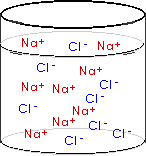

Current and Resistance
Electric Current
 Consider charges moving through a conductor -- such as a wire.
Consider charges moving through a conductor -- such as a wire.

Current is in the same direction as positive charge movement and in the opposite direction of negative charge movement. Electric current in a common wire is done by movement of (negative) electrons. In semiconductors, electric current is often done by movement of "holes" or electron vacancies that are positively charged. In an electrolytic solution, electric current is carried out by movement of both positive and negative ions.

How fast are these charges moving?

Q = (n A
L) q
Q = (n A vd
t) q
I =
Q/
t = n q vd A
n is enormous so the "drift velocity" vd will be surprisingly small.
(c) Doug Davis, 2002; all rights reserved
Return to ToC